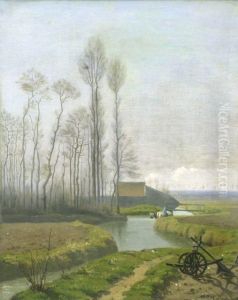E. Bataille Paintings
Édouard Bataille, born in 1857 and deceased in 1911, was a French artist whose work spanned the late 19th and early 20th centuries, a period marked by rapid changes in art and society. Not as widely recognized as his contemporaries, Bataille's contributions to the art world were nonetheless significant, reflecting the aesthetic shifts and cultural transformations of his time. His oeuvre primarily includes paintings, illustrations, and decorative arts, showcasing a versatility and adaptability to the evolving artistic movements of his era.
Bataille's early life and education were deeply rooted in the artistic milieu of Paris, where he was exposed to the burgeoning movements of Impressionism and Post-Impressionism. These influences are evident in his use of color and light, though he never fully embraced the radical departures of these movements. Instead, Édouard developed a distinctive style that straddled the traditional and the modern, often incorporating elements of Symbolism and Art Nouveau. His work, characterized by intricate designs and a vibrant palette, captured the essence of fin-de-siècle France, reflecting the society's fascination with beauty, nature, and the exotic.
Throughout his career, Édouard Bataille was involved in various projects that highlighted his diverse talents. He contributed to the decorative arts through designs for textiles, wallpaper, and ceramics, embracing the Art Nouveau movement's ethos of bringing art into everyday life. Bataille's illustrations for books and magazines were also well-received, showcasing his skill in capturing the human form and his imaginative approach to narrative art.
Despite his artistic achievements, Édouard Bataille's work did not achieve the same level of fame and recognition as some of his peers. His death in 1911 marked the end of a career that, while not widely celebrated, contributed to the rich tapestry of French art at the turn of the century. Today, scholars and collectors are beginning to reevaluate Bataille's legacy, recognizing his role in the transition from traditional to modern art forms. His works, once overlooked, are now appreciated for their beauty, craftsmanship, and unique place in the history of art.
